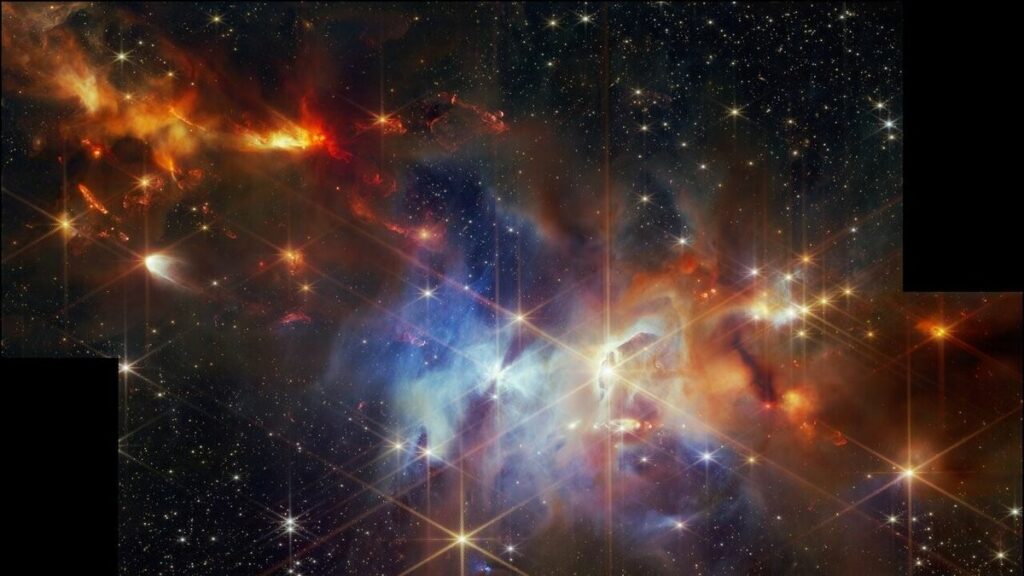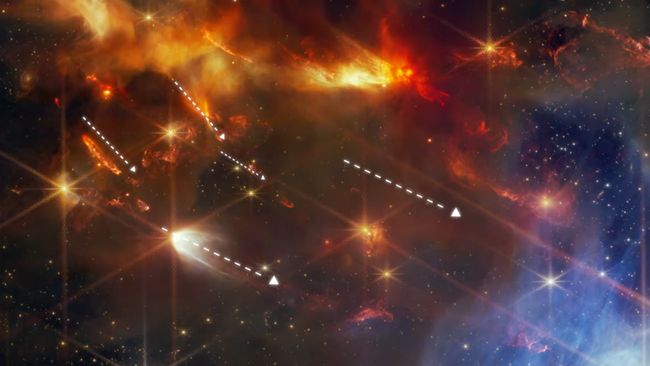The James Webb telescope has detected twelve newly formed stars emitting gas in a uniform direction
As was observed by the James Webb telescope recently, there is a bunch of young stars that eject material into space along the jets in almost the same direction. This might potentially help expose new information on the process of stars formation.
Astronomers using the James Webb Space Telescope (JWST) have observed a strange stellar phenomenon for the first time ever: A group of newborn stars, as if spraying the walls of the nursery with vivid colors as if they were dancing along side the powerful jets in what seems like a dangerous ballet of high speed. And, as it can be seen, they are all aimed at the single goal, which is rather peculiar.
This serendipitous discovery provides the first clues of something called protostellar outflows – gigantic fountains of gas protostars angrily spew out, which collide with and ionize particles in the surrounding molecular clouds. But it also reveals a baffling new mystery: Why, if the identified jets are in a new generation and originate from various distances from the observed core, do they have the same orientation?
These observations, expounded in a new paper in the Astrophysical Journal, reveal new and more information about how stars form and how they perish.
“The players known as astronomers already assumed that as clouds and dictate in stars form, the stars are going to twirl so,” noted Pontoppidan, main organizer of the venture from NASA ‘s Jet Propulsion Laboratory. However, this has not been seen so directly before, can economists make qualitative predictions again, they will see that this is what they did before. These linear parallel features are the dying testimony of the natural cause of the formation of stars.
The newly imaged baby stars share a nursery in the Serpens Main nebula — a vast and sinuous cloud of star-forming gas located in the Serpens constellation, roughly 1,300 light-years from Earth, according to NASA. Astronomers observed the nebula with JWST’s powerful Near-Infrared Camera (NIRCam), taking note of the hot, ionized trails of gas pushing through the star-forming cloud.

The area under consideration revealed at least 20 newly born stars that are already showing activity of protostellar outflow. Among them, there is a cluster of 12 stars which can be seen in the upper left corner of the JWST image appealed to the team. These stars all pointed out jets from them, and all of them have been pointed in a rathered similar direction, just like water droplets speeding down during rain as provided by NASA. The team went further and suggested that these outflows are fairly young having originated between 200 years and 1, 400 years ago.
Importantly, the perfectly-aligned outflows reported in this study have never been recorded before and it is improbable that they occurred merely by chance. The researchers believe that the 12 stars having these structures were born at the same time and right next to each other in a slender string made of dense gas. There are more details on the borders of the star-forming filament, which was noticed to have a very strong magnetic field; this is probably responsible for the orientation of the angle of the protostellar jets. However, the stars can come into contact with other celestial bodies that slow the spins of individual stars and divert the jets. This relative drifting over time could be the reason as to why astronomers have never observed such perfect alignment.
This pattern suggests that there could be useful information on the nature of star formation For a better understanding of these coordinated outflows, more research should be carried out into the phenomenon. The next thing that researchers look forward to doing is the use of JWST’s Near-Infrared Spectrograph (NIRSpec) to explore the details of Serpens Main with more detail, including the chemistry of this monster star-formation zone. This could help explain the process by which materials are passed from stars to young planets; this understanding would aid in the collective knowledge about the creation of solar systems that are like the one in our own galaxy.
Do not forget to share your opinion with us to provide you with the best posts !




0 Comments